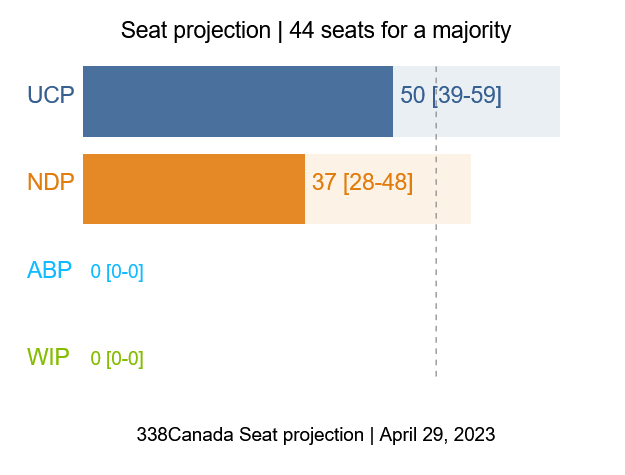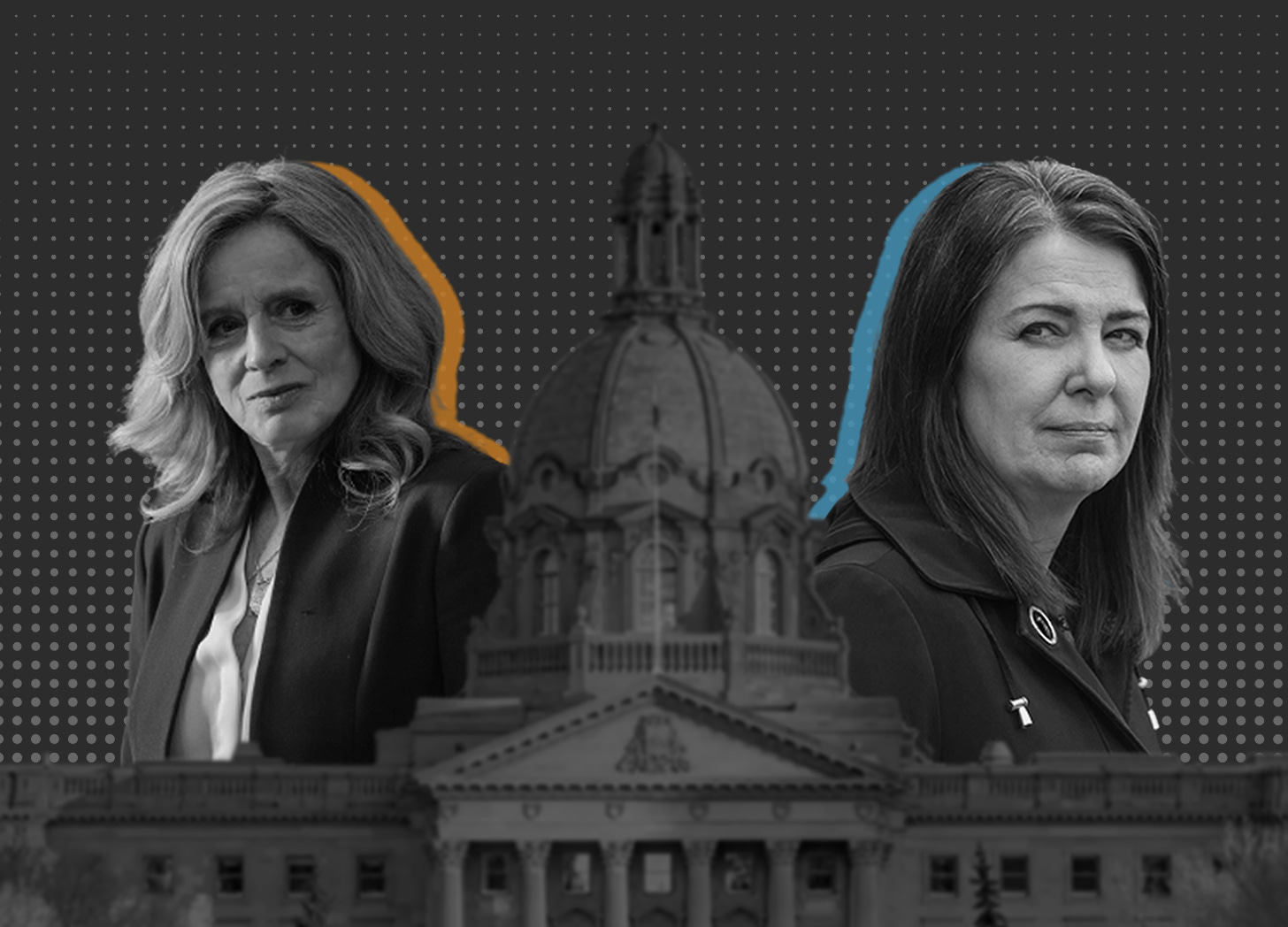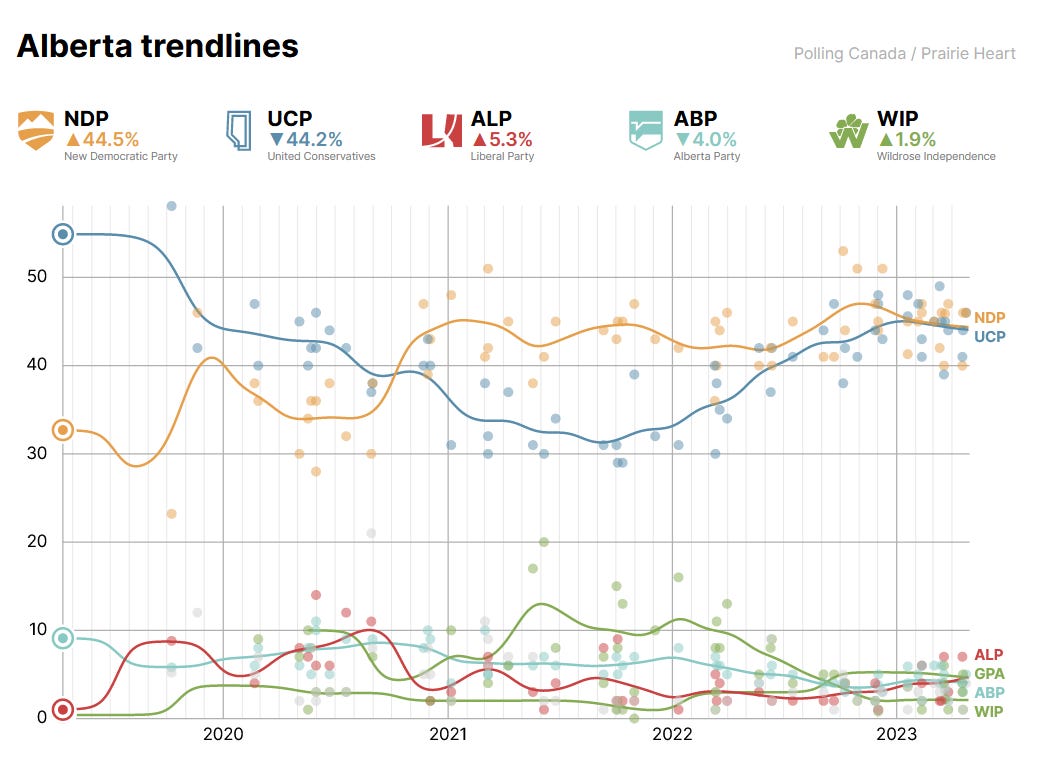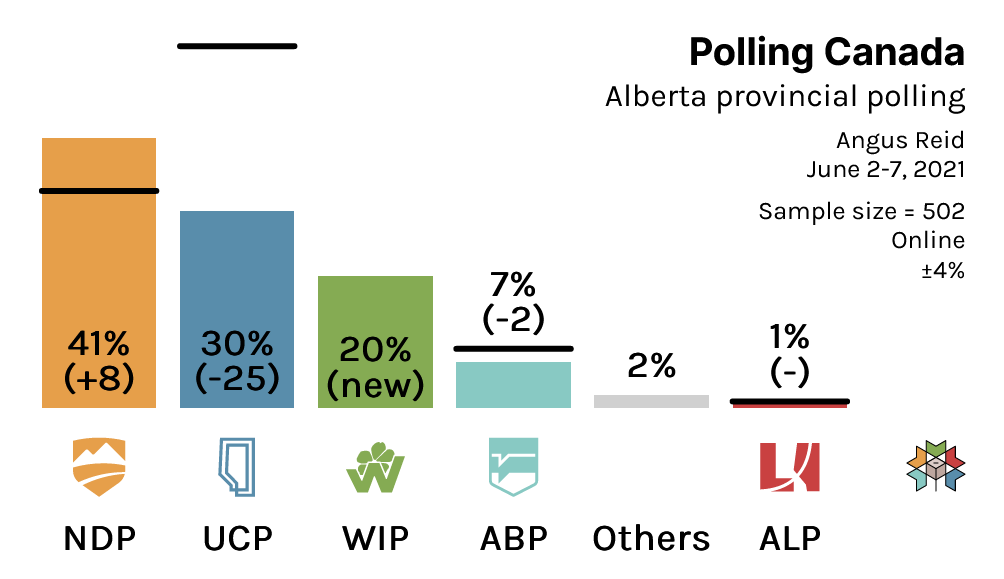Alberta 2023: Two Party Election In Action
Albertans are heading to the polls at the end of May in an election set to pit the United Conservatives against the New Democrats
Background
The 2023 Alberta election will see the incumbent United Conservative Party (UCP) go up against the New Democrats (NDP) for control of government.
The UCP swept to power in 2019 with a 63-seat majority under then UCP leader Jason Kenney. Prior to that election, the right was splintered between the Wildrose Party and the Progressive Conservatives; Such a split helped to propel the NDP into government in 2015. Meanwhile, the NDP were forced out of their one-term government and sent to the Opposition benches with 24 seats under former Premier Rachel Notley.
The 2019 election also saw the Alberta legislature become home to only two parties after the Alberta party, which previously held 3 seats prior to 2019, lost all of their seats. The Alberta Liberals also saw their only seat plucked from them during that election.
On Your Marks…
New Democrats and Conservatives are in for a real tight race this election.
Since Danielle Smith entered the hotseat as UCP leader, the party has recovered support that was previously lost to the Wildrose Independence Party (WIP), an upstart party with notions of western independence for Alberta from Canada. The UCP took a heavy hit in the polls from that support leaking over to the WIP between 2020 and 2023. But, in part thanks to Smith’s personal political positions, she’s been able to win back support that Kenney previously lost in the interim period between elections, and just in time too.
Amazingly, compared to their 2015 results when they won government, the NDP are pulling in more of the vote today. In 2015 they won government while taking 40.6% of the vote and now, on the near-eve of the Alberta election kicking off, they’re sitting at an average of 44.5% in the polls. The UCP on the other hand are down to 44.2%, a noticeable drop-in support compared to the 54.9% they pulled during the 2019 election.
Meanwhile the smaller parties are way, way behind the two main parties. Despite polling, on average, around 5.3% the Alberta Liberals are much likely a lot lower than that (A couple of Innovative polls have unrealistically bumped the Liberals up in the averages despite other pollsters having them closer to 1%, if they even register. This is also the case with the Greens). The Alberta Party has lost half of its support since the 2019 election, setting them back at 4% on average.
The biggest rise and fall between elections was for the WIP. Coming out of the blue, the highest they ever polled was in June 2021 when they managed 20% in an Angus Reid poll. The UCP tanked to 30% in that same poll and would’ve left a hypothetical election wide open for the NDP. Most of the polls that had the WIP polling close to 20% were from Angus Reid, aside from a Mainstreet Research poll that also had the WIP at 17% at the same time. Alas for the WIP, that was two years ago.
Get Set…
For anyone who’s been paying attention to Alberta politics, what I’m about to say will be obvious. But for those new to Alberta politics or who have a less firm grasp on it, let’s quickly dive into one question; Who’s going to win in Alberta?
The answer to that, quite simply, will end up being “Whoever can win most of Calgary.”
Stronghold Edmonton, barring a complete collapse of the NDP which is very unlikely at this point, will continue to be a stronghold for the NDP. They won all but one seat in Edmonton in 2019, an election that saw the NDP kicked out of the governing seat. In short this will make Edmonton rather unremarkable to watch. How about the rural parts of the province?
Just like everywhere else in this country, the rural parts of Alberta (Anywhere that’s not Edmonton and Calgary) are heavily dominated by Conservatives and will continue to be. There are a couple weaker ridings out in rural Alberta that could flip NDP if the numbers swing the right way, but it’s safe to say that the overwhelming majority of UCP MLA’s that are out in the boonies will be just fine come election night.
So that leaves Calgary, the one part of the province that is ‘swingy’ between the two main parties. Based off previous election results, southern Calgary is much firmer in its support for the UCP and will be harder for the NDP to crack. However, the northern half of the city is ripe for potential NDP gains come election day given the much weaker UCP wins in the previous election. It’ll all depend on how voters in each of the Calgary ridings vote, of course.
Enjoying this content? We’re focused on providing content and coverage free of charge to everyone. So if you like what you see, consider donating to Polling Canada over here!
(Hold On, Where Are We Now?)
As it stands right now, the UCP hold the edge going into the election. According to our good friend Mr. Fournier over at 338Canada, we have a rough idea as to how the election will kick off.
As of the moment, the 338Canada Alberta model has the UCP sitting comfortably ahead with 50 projected seats while the NDP is at 37. Certainly an improvement for the NDP and a weakening of the UCP (As the polls previously mentioned would suggest) but that hold around Calgary is still favouring the UCP just enough to keep them in power.
Ironically enough, there are 7 seats in the current iteration of the 338Canada Alberta model that are still held by the UCP in Calgary would be just enough for the NDP to hit the 44-seat mark needed for a majority. But, like I said earlier, there are some rural ridings that the NDP could pick up here and there to make up the difference, including a couple of the outlying ridings around Edmonton’s fringes.
The NDP are still the underdogs going into this election and I have no doubt that they’re going to act as such.

Go!
2022 was a year of elections that were boring and pre-determined in their outcomes. Legault and Ford cruised to easy re-elections in Quebec and Ontario, respectively. Aside from the PC’s dominating in PEI, 2023 is setting up to have some very competitive elections. The PC’s are struggling against the NDP in Manitoba and they’re set to go to the polls in October. Then there’s Alberta in May!
The New Democrats and the Conservatives are going to go at it extensively this election. Personally, I wouldn’t be surprised if it ends up being fairly nasty in terms of the mudslinging that’ll go on this election (These things happen when it’s as close as this). I also wouldn’t be surprised if we see a lot of policy proposals, from both parties, that are focused on winning over Calgary voters. Not only that but the NDP and UCP have been able to clear their respective ideological lanes that would’ve otherwise risked vote splitting on either side.
The UCP and NDP are going to be the only parties able to field a full slate of candidates in Alberta. The Greens are lagging with little over 30 candidates in 87 of the ridings up for grabs. The Alberta Party and Liberals are even further behind with 18 and 11 candidates, respectively, and for anyone thinking the WIP will be a threat to Danielle Smith, think again. The WIP has only fielded 2 (Yes two) candidates thus far in the ridings of Innisfail-Sylvan Lake (Won by the UCP in 2019 with 74.5%) and Highwood (Again, won by the UCP with 73.3%).
But elections have a tendency to change things! One bad blunder on the part of a leader/party or one spectacular moment on the campaign trail can turn a stalemate into a runaway election. Will that happen in Alberta? Time will tell.






